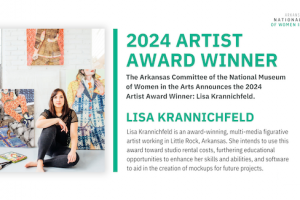THE LEGACY ISSUE: The Advocates

The economic impact of the arts in Arkansas cannot be ignored. In 2014, gallery owner Garbo Hearne teamed up with Mitch Mitchell to create Arkansans for the Arts, a nonprofit organization devoted to emphasizing the importance of this $2.9 billion industry, which accounts for over 33,000 jobs, in our state. Garbo served as board chair for several years and recently stepped down, handing the reins to Sandy Martin of Eureka Springs. Sandy is no stranger to philanthropy; she currently serves on many boards including those of FilmNWA, Northwest Arkansas Tourism Association and the Arkansas PBS Arts Advisory Board. Together, they are uniting creatives, nonprofit organizations and legislators to give the arts a seat at the table for economic growth.
How did Arkansans for the Arts come about?
GARBO / In 2014, Arkansas was recognized as one of five states that did not have a statewide advocacy organization. Americans for the Arts encouraged Arkansas to organize and participate in a three-year challenge grant to study and report the impact of arts advocacy on arts education, (SP3). With support from the Windgate Charitable Foundation and the Governor’s office, Arts Advocates Arkansas (AAA) was formed. In 2016 we changed our name to Arkansans for the Arts (ARftA). ARftA completed the SP3 project in 2017.
Today, we have a strong, diverse board of directors and advisors representing the entire state. We are proud that the board reflects the diversity, culture and depth of the arts and creative economy disciplines of Arkansas. The effort to champion the changing of the narrative around the arts and emphasizing the arts tremendous impact on the economy, education and creative talent development in Arkansas became ARftA’s drumbeat and continues to be our mission.
“The arts” is a broad term. What are some of the categories you’d put under this? GARBO / To truly understand the arts, you need to understand what makes up the creative economy and creative industries – all of which are dependent upon arts skills and talent.
This list is too extensive to be covered in this article, but here are a few of the obvious categories:
Visual, performance, literary, culinary, film, digital production, music, animation, architecture, health/art therapy, fashion design, product design, online software/application/games, cultural/historic, journalism, communications media, architecture, healing arts/therapies—just to name a few.
What are the different ways to advocate for the arts?
SANDY / A good portion of arts advocacy has traditionally danced around the soft edges with a focus on the visual and performing arts. While those disciplines are very important, the arts are much broader and represent a large portion of the state’s economy. Through the development of our Creative Economy Committee, we began to focus on the economic impact of the creative industries. Through our research, we are able to demonstrate impact in real numbers of jobs, revenue, community development success stories and—most importantly—the role that the arts play in growing, retaining, retraining and attracting talent for Arkansas. Our advocacy efforts are focused on ARTS MEANS BUSINESS.
One of our first initiatives was to meet with Senator Joyce Elliott to share our research and focus. She immediately grasped the importance and power of the arts for economic and workforce development and assembled a bi-partisan Arkansas Legislative Arts Caucus (LAC). We work closely with LAC co-chairs Senator Elliott and Representative Les Warren to develop policy recommendations and strategies.
To advocate effectively, it is important to have data, connections, open dialogue, strong, simple visuals and personal stories. Arkansans for the Arts provides those tools through our statewide reach and strong board of directors and advisers representing every district in the state. We provide services that translate those tools into infographics, videos, articles [and] blogs, town hall meetings, and opportunities to learn and share from peers, legislators, funders and our network of national and regional partners. We are in constant communication with our members to assist in their advocacy efforts.
A 2021 goal is to launch the first Advocacy Leadership Institute in Arkansas. Through the Institute we will train artists, arts organizations, students, economic developers and influencers on advocating for the arts and creative economy. They will benefit from our up-to-date county level data and our powerful communications platform, VoterVoice.
Advocating for the arts isn’t one-size-fits-all. Different messages and strategies are required for different issues and audiences. Arkansans for the Arts demystifies the art of advocacy and helps our members learn how to customize it for their needs.
We are particularly interested in helping students and younger creatives become advocates. They are the workforce of today and the future workforce and the talent pipeline Arkansas desperately needs to grow and retain. Too many are forced to leave the state due to lack of employment opportunities. Yet everywhere you look businesses and groups are screaming for talent. We have the talent and we aim to give them a stronger voice to keep them here.
What is the relationship between the arts and economic impact?
SANDY / Direct! Which is why Arkansans for the Arts is seeking a designated seat for the creative economy and arts on the Arkansas Economic Development Commission.
Arts Means Business because the arts create jobs, revenue and talent.
Examples: 1) Tourism is the second largest industry in Arkansas and that industry is predominantly driven by the arts; 2) Community development/rehabilitation like Ft. Smith’s 64.6 – and new cultural district in Pine Bluff. These initiatives and development projects are anchored by the arts because the arts are a major draw for community participation, residents (quality of life), attracting new businesses and creative talent – all stimulating the local and state economy while retaining a large pool of creative talent.
Until we seriously integrate arts in education at every level, but especially K-12, Arkansas will not be competitive in today’s [economy].
What are some of the arts categories that have the greatest economic impact?
SANDY / Tourism, film and digital production, cultural heritage, performance (theatrical, music, etc.), architecture/design and product development.
How are you working to influence the Arkansas legislature to support the arts?
GARBO / We are working closely with the Legislative Arts Caucus led by Senator Joyce Elliott and Representative Les Warren to develop legislation for a statewide cultural asset inventory and Arts+Technology Boot Camps. We respond to their requests for data and information on the state and national level. They are invited to and do participate in virtual and in-person meetings with their constituents.
We have an active Legislative Committee and Creative Economy Committee that develop research, strategies, infographics and tool kits to share with legislators and members.
Through our partnerships with Americans for the Arts on the national level, Mid-America Arts Alliance on the regional level and the Arkansas Arts Council on the state level, we organize and produce Arkansas Arts Advocacy Days and town hall meetings with members and legislators throughout the state.
What are some ways our legislature could support the arts right now?
SANDY / 1) Direct relief funding to artists and arts organizations particularly in rural areas; 2) To provide equity in support and funding for BIPOC artists, arts organizations and communities; 3) Support expanding the arts in education at the K-12 level 3) include the arts in CTE programs; 4) Support legislation that integrates the art in health and wellness (art therapies, military, post-pandemic); 5) Support Arkansans for the Arts initiative to do a statewide inventory of all cultural and arts assets to identify the gaps and opportunities; 6) Embrace the fact that Arts Means Business through revenue, jobs and talent, and include the arts in every policy and piece of legislation pertaining to education, economic development and workforce development.
What are some of the long-term goals for Arkansans for the Arts?
GARBO / To secure a seat on the Arkansas Economic Development Commission designated for the Creative Economy/Arts & Technology. (This is a short-term goal.)
To celebrate the rich culture of Arkansas by elevating support, funding and recognition of diversity and inclusion through the arts.
To continue membership growth and influence as the voice of the arts and experts in support of Arkansas’ creative economy.
To produce a large pool of young professional arts advocates informed with strategies, tools, access and research to persuade policy within their communities and throughout the state.
What have been some challenges Arkansans for theArts has faced?
GARBO / COVID-19 hit the arts hard. Oddly enough the pandemic also gave more purpose to our organization. Our members need us now more than ever. In the new virtual world, technology is a challenge. It provides a platform for gathering, but not the human touch or time needed to really connect and explore solutions for recovery and sustainability. We are, however, collecting stories and data on how resilient the arts community has been and how important the arts are for the public to help them connect and survive during these times. Unlike other industries, the arts pivoted quickly to create innovative solutions for survival.
Prior to the pandemic, one challenge we faced was how to effectively reframe the conversation about the arts and clearly [communicate] what the creative economy is and its value. The data and research available are from 2017 or is COVID-19 impact data neither of which are relevant. However, we have overcome that obstacle by investing in a new research tool that will provide current data on the creative economy.
Arkansans for the Arts is committed to identifying and breaking down the barriers that we face in Arkansas around diversity, inclusion, and equity. We believe the arts are an extremely important factor to address these issues and make positive, lasting change.
We are also committed to the student population of Arkansas. Their world has been turned upside down, too, and it is difficult to reach out to them now. We work with Students for the Arts but need to develop other ways to connect with youth. It is our goal to help them become advocates and to understand their value and contribution to the creative economy. We lose too many of our talented students who have to move out of state for jobs. Their strong voice will help us get that message across to employers and policy makers. The talent Arkansas seeks is right here – we just have to recognize them.
Finally, Arkansans for the Arts has also been impacted by COVID-19. We also face the challenge of sustainability and need to increase our membership and funding support.
How can people advocate for the arts personally?
SANDY / Learn how to briefly tell their personal story about what art means to them and why it is important in their life, jobs, early education, communications, social justice and the ability to think creatively and to problem solve. What would life be without the arts? How much do they typically spend (in time and money) in a year interacting with the arts (going to concerts, performances, creating art, learning art, eating out, watching a film, tv show, playing a video [or] computer game, going to websites, consuming media, reading a book or magazine, enjoying public art and architecture, going to museums, learning about other cultures through the arts, visiting a website or downloading the latest interactive app). Go to the Arkansans for the Arts website and download infographics, factsheets, articles and reports to support their story.





Comments